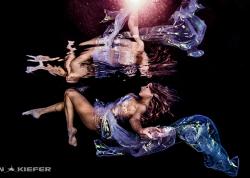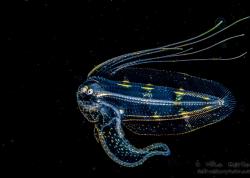A Photographer's Guide to Muck Diving

The scuba industry has coined the phrase “Muck Diving” to describe a style of diving or a location. Most of these muck dive sites/locations share many of the same characteristics worldwide and should be approached differently than their reef or open water counterparts.
Muck sites are often delicate estuary-type habitats that support very small creatures that settle as post-developed larvae to spend their entire lives on the open sand flats. With very little in the way of protection, these highly adapted critters find quick shelters under the sand or in rubbish, discarded household goods, in algae or any other protective objects. Shooting images of these critters will pose many challenges to new and experienced photographers alike.
Jawfish egg detail.
Exceptional images are created by the photographer as a result of his or her skills, regardless of whether the camera is a compact, Micro 4/3 or DSLR. It is entirely up to the photographer to create a compelling image. Like golf, shooting images underwater is all in the approach, and the end result depends heavily on how the setup is performed.
Talking about shooting is the easy part - the reality is that everything underwater is moving and oftentimes doesn’t want to cooperate. Sometimes the creatures aren’t in the right position or the action is happening to fast to capture. For this I always encourage a large helping of patience and observation. Watching the behavior will give you better insight on how to capture that special image and how to anticipate capturing it.
Below are my 5 tips on preparation for muck diving and 5 tips on photo design and composition.

Preparation
Minimize shooting variables before you get wet. Preset your ISO. I shoot at the lowest ISO setting possible for better noise control. Set your shutter speed and strobe setting in anticipation of your subject before jumping in. Streamline your dive kit and think simple. The last thing you want is to be distracted by your camera and kick up silt on the muck bottom.
Familiarize yourself with the mechanics of your camera and its functions. I prefer to use the spot focus indicator in the viewfinder to create better compositions.
Concentrate on your technique underwater. How you approach your subject, holding your camera, composing images and even strobe angle should all be considered technique.
Select the right lens for the subjects you anticipate finding on muck dives. Palm-sized critters and larger are best shot with a 60mm lens. Subjects smaller than palm-size require a 100/105mm lens.
Get creative by changing your f-stop settings or composing in portrait orientation. Try shooting with a single strobe, a strobe snoot or reverse rings.
In addition, getting to know the basic anatomy of your subject is a reliable way to nailing your shots. Examples include knowing where the eyes are located on a tiger shrimp, how a boxer crab really behaves and preparing ideas for photographing a hairy frogfish. Learning these traits is best performed before the trip so that you have ample time to prepare.

Photo Design and Composition
Filling the frame with your subject is essential for true 1:1 macro or greater. Get close to your subject and minimize the water between the lens port and the subject. Look for natural flow. Pay attention to the direction your subject is facing and how it is positioned. Creating a natural flow within the frame increases the WOW factor, elevating an ID book image to a real photo.
The rule of thirds is the most basic but reliable composition method for all art and photography. Visual balance is achieved by anchoring your subject to the intersecting lines of a Tic-Tac-Toe grid, which happens to be about 1/3 of the way into the frame. Grid overlays in your Lightroom settings are available and will help you understand this process a bit more, teaching you how to apply it when shooting the image. See more on this in the guide to underwater compositions.
Be patient. Try to capture the essence of the action by being patient. When your critter is first approached it will be in fear of being eaten (by you), so stay calm and allow it to get used to your presence. Once it becomes more comfortable and goes back to natural behaviors is the time to try to capture a photo. A subtle movement or a Frogfish’s profound yawn can make your image special and stand out from the rest.
Contrast. Always consider the entire frame, because sometimes what isn’t in the image is as important as what is. Negative space adds natural contrast. Shallow f-stops will bokeh the reef or whip coral in the background.
Break out. Try something new on each trip. Try shooting super macro, using a snoot or a new lens. Take the time to Break Out from your old habits and do something new and daring, like using manual power on your strobes - go crazy!

Lenses for Muck Diving
Muck diving is all about macro images, which need to be shot with dedicated macro lenses. Prime lenses are the best choice because they yield sharper images with better contrast.
For Canon and Nikon users, the 60mm, 100mm or 105mm will be the natural lenses to select. Yes there are other choices, but I will refrain from expanding. So what’s the difference? Each of these lenses has the exact same reproduction ratio maximum of 1:1, but operates at a different focal length.
60mm Macro Lens
A 60mm lens is versatile - great for night diving and low light situations and as well as close, tight macro. They are often regarded as a workhorse lens for basic, effective macro photography.
Operate with a very short working distance; lens to subject is only a few inches.
Great Bokeh, sharpness and versatility.
Target selection: Subjects palm-sized and larger.
Teleconverters: An inexpensive way to increase magnification. Note that using a TC will increase your working distance slightly.
Diopters: Not recommended but can be used in a pinch

100mm (Canon) or 105mm (Nikkor) Macro Lenses
These are more specialized lenses best suited to animal behavior, fish photography and super macro (with diopters).
Narrowed angle of view and more magnification makes it easier to fill the frame.
Exceptional Bokeh, sharpness and contrast.
Target selection: Palm-sized to fingernail-sized critters.
Teleconverters: Great for shooting fish with eggs and increasing magnification at a slightly greater working distance.
Diopters: Highly recommended. SubSee, Nauticam, Inon, Saga and Bluewater all make these wet lens attachments. They all work with a variety of results depending on camera gear.
Diopters decrease the working distance and dramatically increase your reproduction ration. Target selection is reserved for the very small as the DOF is extremely narrow and can limit the users’ compositions to head-on or profile images.

When preparing for your next muck dive, whether a dedicated trip or single dive site, be sure to do your homework and be prepared - you never know when that once in a lifetime opportunity will arise. Being ready for that moment will make all the difference.
Now get out there and have a muck diving adventure!

Join Mike on a muck diving & photo adventure in world-famous Lembeh Strait.
June 3-14, 2014 at Kasawari.
Further Reading
RECOMMENDED ARTICLES
SUPPORT THE UNDERWATER PHOTOGRAPHY GUIDE:
The Best Service & Prices on u/w Photo Gear
 Visit Bluewater Photo & Video for all your underwater photography and video gear. Click, or call the team at (310) 633-5052 for expert advice!
Visit Bluewater Photo & Video for all your underwater photography and video gear. Click, or call the team at (310) 633-5052 for expert advice!
The Best Pricing, Service & Expert Advice to Book your Dive Trips
 Bluewater Travel is your full-service scuba travel agency. Let our expert advisers plan and book your next dive vacation. Run by divers, for divers.
Bluewater Travel is your full-service scuba travel agency. Let our expert advisers plan and book your next dive vacation. Run by divers, for divers.

































